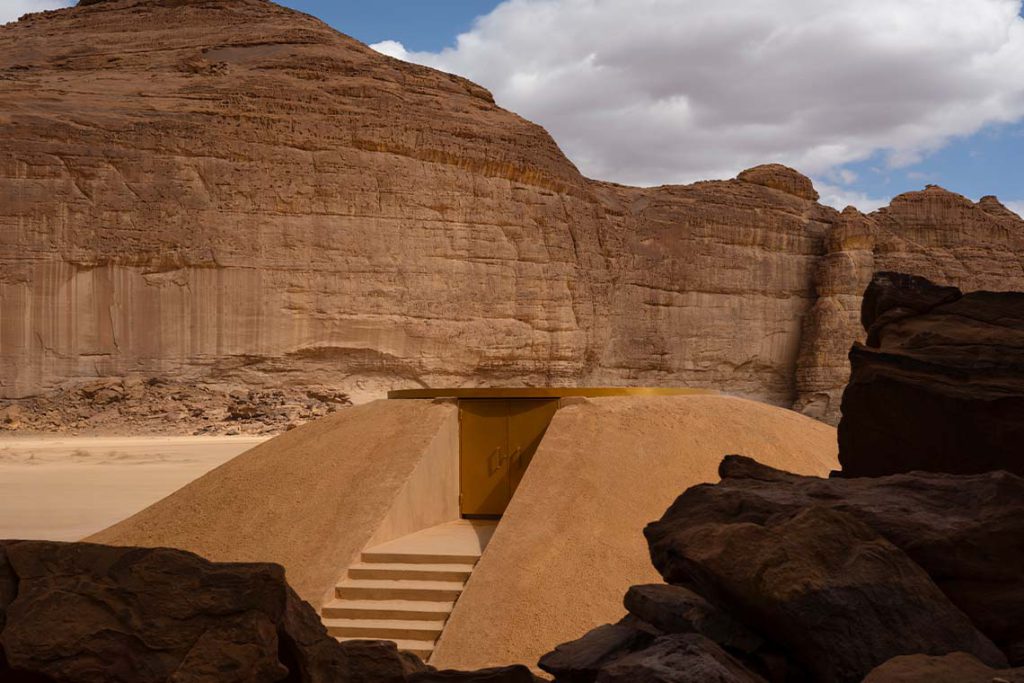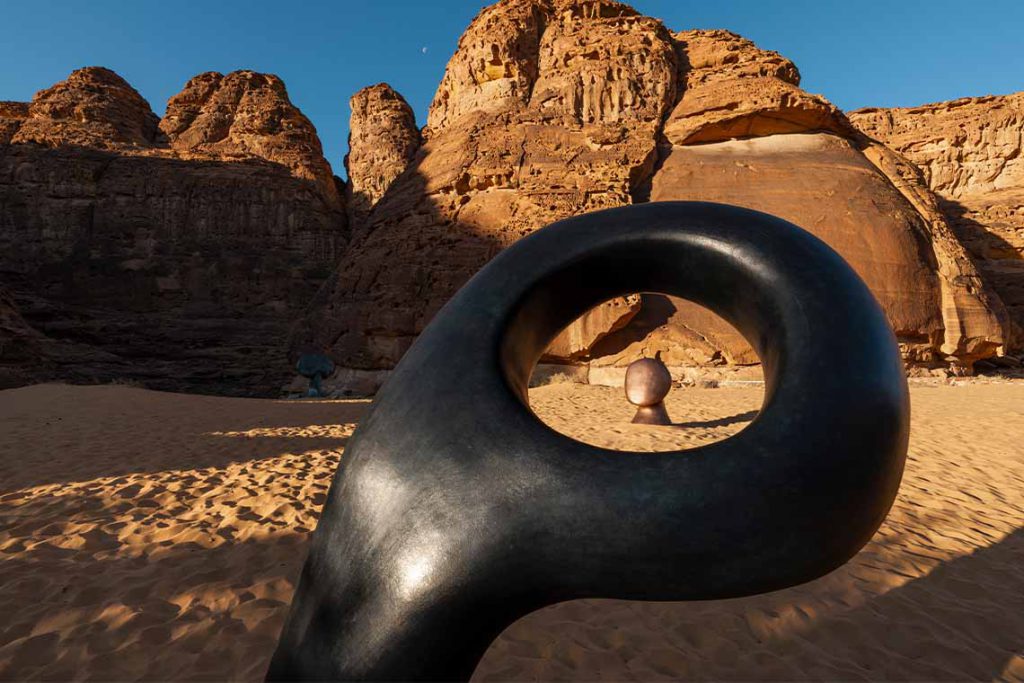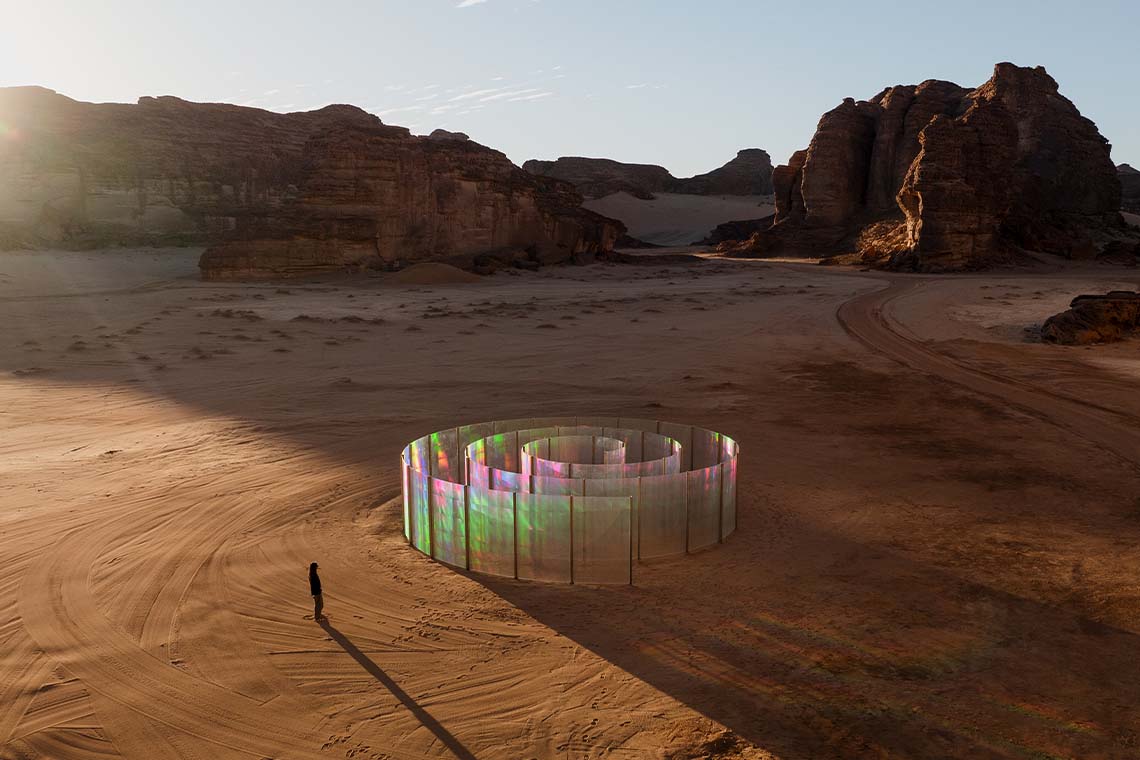Desert X AlUla celebrates its third iteration with an expansive exploration of ‘the great unseen’ and of the intangible qualities and layers that both define a landscape and push artists into new realms of thought and expression.
An ebony-coloured raven flaps purposefully overhead, heading off to roost as the setting sun’s last few rays flood across virtually lunar scenery. Glinting stones are all around. “It’s a protected landscape,” explains artist Caline Aoun as we contemplate her installation The Desert Has No Surface, set within the black basalt expanse of Harrat Uwayrid, a rock-strewn plateau and part of a biosphere reserve. “I had to take special care not to disturb any aspect of the natural environment here and wanted to be respectful at all times.”
Comprising a circle of hand-picked stones, each water-polished on one side only and carefully set into the naturally rocky topography, Aoun’s compelling work called for a particularly sensitive approach. A temporary wooden platform was constructed so her stones could be transported to the exact location for assembly without disturbing the protected terrain, and a thin textile mat was laid over the natural rocks to shield them before Aoun could place her own pieces on top. Yet the physical materiality of the stones is only part of the story she is telling. “All the solid substances on which we walk are in continuous dialogue with the air and other forces, which change their appearance and qualities,” she says. It’s a process that unfolds before our very eyes, as the polished angled surfaces of the stones refract and gleam in the gloaming.

Curated by Maya El Khalil and Marcello Dantas, with artistic direction from Raneem Farsi and Neville Wakefield, this third edition of Desert X AlUla is couched around explorations of relative and potential invisibility, as well as concepts of transience and temporal illusion. Addressing the theme In the Presence of Absence, 17 artists present works across three locations: Wadi AlFann, the permanent land art site and extravagant showpiece of Saudi Arabia’s red-hot art scene; Harrat Uwayrid, raw, stark and forbidding; and AlManshiyah Plaza, in AlUla town itself, adjacent to the historic railway station. The often-overwhelming majesty of the desert landscape in this part of Saudi Arabia is both a challenge and opportunity to those participating in Desert X AlUla, which makes the plaza an interesting counterpoint to the epic sweep of mountain and sand. Some might argue that it’s hard to fail with art presented in such a setting, but there’s much more going on than simple product placement. “The scenery is of course monumental and inspirational,” El Khalil says to me, “but it’s the individual responses of the artists, and what they bring to the landscape, that make for a truly special experience here.”
Some artists have responded more convincingly than others in their exploration of what El Khalil and Dantas call the “something else” that has shaped the landforms, geology and metaphysical language of the desert, but the overall suite of site-responsive works is coherent and thoughtfully curated. It’s tempting to conclude that the most successful are, like Aoun’s, those that are melded into their setting – Sara Alissa and Nojoud Alsudairi’s astutely executed Invisible Possibilities: When the Earth Began to Look at Itself and Karola Braga’s ingenious incense-belching mound, Sfumato, also stand out in that respect – but the wider picture is not so straightforward. I also enjoyed the boldness and funky incongruity of Kimsooja’s To Breathe, a prismatic, iridescent spiral that seeks to expand understanding of the desert environment rather than trying to become part of it. Filwa Nazer’s Preserving Shadows, a skeleton-like bridge to nowhere, is also provocative in its attitude to the landscape – an architectural mantis that both confronts and articulates the hostile qualities of the desert.

Much is made by the Desert X brand of the ‘leave no trace’ principle, that any artistic intervention is intrinsically reversible and can be installed and removed without a lasting physical impact on the landscape. Inevitably a fine line to tread, so it is perhaps surprising to see one of Ibrahim Mahama’s works physically attached (bolted, one assumes) to a rockface. It underlines the dilemma that arises when art meets landscape on this scale and perhaps helps explain why some of the most powerful works in terms of legacy are paradoxically those that are ephemeral and detached, either in form or concept. Like desert will-o’-the-wisps, they are here one moment and gone the next. “You have to turn off your phone and turn on your other channels of perception,” Dantas points out.
Rand Abdul Jabbar’s five sculptures Where myths are born of mud and desire interpret the story of Venus and was given a dramatic dimension by a special performance from the artist, who walked among her pieces, proclaiming and extolling. When she stopped, the void spoke volumes. The ultimate impact of such fleeting presences hit a genuinely emotional note with Tino Sehgal’s special commission, un titled. A performative piece based around human sound, movement and sensory interaction with the physical and intangible elements of the desert, its call on the imagination of those present moved many to tears. I rejoiced in the knowledge that no photographic or video record of it was permitted.



